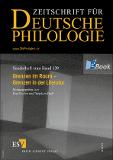Files in this item
‘“Hier ist die Grenze […] Wollen wir darüber hinaus?” : Borders and Ambiguity in Fontane’s "Unwiederbringlich"
Item metadata
| dc.contributor.author | White, Michael James | |
| dc.date.accessioned | 2013-05-31T12:31:01Z | |
| dc.date.available | 2013-05-31T12:31:01Z | |
| dc.date.issued | 2010 | |
| dc.identifier | 43033406 | |
| dc.identifier | 428ebe53-13bb-47bc-9aa0-07e9079a827d | |
| dc.identifier.citation | White , M J 2010 , ' ‘“Hier ist die Grenze […] Wollen wir darüber hinaus?” : Borders and Ambiguity in Fontane’s "Unwiederbringlich" ' , Zeitschrift für deutsche Philologie, Sonderheft , vol. 129 , pp. 109-123 . | en |
| dc.identifier.issn | 0949-1678 | |
| dc.identifier.other | ORCID: /0000-0001-9128-4747/work/60427379 | |
| dc.identifier.uri | https://hdl.handle.net/10023/3587 | |
| dc.description | Sonderheft "Grenzen im Raum, Grenzen in der Literatur" | en |
| dc.description.abstract | Theodor Fontane’s „Unwiederbringlich“ may be productively read as an exploration of boundaries. The historical context creates a distinction between bordered and unbordered spaces, between crossing thresholds and staying within limits. This double focus mirrors the text’s thematics, in which clear thresholds in morality and time are balanced against exhortations to relativism. The represented landscape reproduces this antithesis and functions as a symbolic map against which Holk’s and Christine’s actions and feelings may be read, charting trespass and ironic misunderstanding. A study of boundaries in the text reveals a complex and multifaceted spatial symbol appropriate to a literary exploration of thresholds in human life. | |
| dc.format.extent | 15 | |
| dc.format.extent | 1471765 | |
| dc.language.iso | eng | |
| dc.relation.ispartof | Zeitschrift für deutsche Philologie, Sonderheft | en |
| dc.subject | Borders Fontane Unwiederbringlich | en |
| dc.subject | PT Germanic literature | en |
| dc.subject.lcc | PT | en |
| dc.title | ‘“Hier ist die Grenze […] Wollen wir darüber hinaus?” : Borders and Ambiguity in Fontane’s "Unwiederbringlich" | en |
| dc.type | Journal article | en |
| dc.contributor.institution | University of St Andrews. German | en |
| dc.description.status | Peer reviewed | en |
This item appears in the following Collection(s)
Items in the St Andrews Research Repository are protected by copyright, with all rights reserved, unless otherwise indicated.

